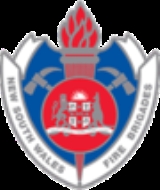
New South Wales Fire Brigades
Encyclopedia
Fire and Rescue NSW, an agency
of the Government of New South Wales
, Australia
, is responsible for firefighting, rescue
and hazmat services in the major cities, metropolitan areas and towns across rural and regional New South Wales
. Fire and Rescue NSW is the seventh largest urban fire service in the world, with more than 6,900 firefighters serving at 339 fire stations throughout the state, 418 support staff, and 6,000 community fire unit volunteers. It also works closely with the Rural Fire Service
.
The agency operates pursuant to powers set out in the and was initially formed in 1910 as the New South Wales Fire Brigades, with its origins going back to 1884 as the Metropolitan Fire Brigade.
The agency is led by the Commissioner of Fire and Rescue NSW, currently Greg Mullins AFSM
, who reports to the Ministry for Police and Emergency Services
, which is ultimately responsible to the Minister for Police and Emergency Services
, currently the Honourable Michael Gallacher, MLC.
A flag
based on the British
Blue Ensign
with FRNSW emblem is also used.
The Commissioner's official vehicle bears New South Wales number plate
10, which has been on continuous issue to the head of the fire department in NSW from the Roads and Maritime Services
since 1910.
A permanent firefighter is a full-time firefighter. Permanent firefighters work in a fire station as part of a platoon. Each fire station has four platoons on rotating shifts each containing at least 3 firefighters of various ranks, plus a Station Officer. The number depends on the size and nature of the fire station. Each platoon is supervised by a Station Officer. Each fire station is part of a zone containing between nine and 27 fire stations and headed by a zone commander. These zones are then grouped in regions (metropolitan, regional north, regional south, and regional west) headed by a Regional Commander.
A retained station is a part-time station where retained firefighters work. Even though these firefighters work part-time, it should be noted that these members of the community (who often have other full-time employment) are considered professional firefighters who have undergone training so they can attend the same jobs as permanent firefighters. The retained station is not a permanently staffed station, meaning the firefighters are on-call from home or work rather than on duty at the station. However, retained stations respond to emergencies 24 hours a day. Retained firefighters use the same vehicles, equipment and uniforms as their permanent counterparts, the only visible differences being their shoulder and helmet ranks which are red as opposed to white/black.
Some stations employ a mixture of Permanent and Retained Firefighters. This arrangement is common in larger country towns such as Bathurst and Orange where the nearest backup would otherwise be some distance away. The station would typically have one appliance manned by permanent staff as first response, with additional vehicles being manned by retained staff as required. The station may have Permanent day and night shifts or be day shift only, with retained staff manning all appliances at night when they are less hampered by work or other commitments.
Community fire unit
s (CFUs) are volunteer teams of local residents trained to safeguard their homes during a bushfire, until the fire brigades can get there, or to 'mop up' after a fire has passed so fire units can be released to attend more urgent incidents. CFU members are not firefighters. The aim of the CFU program is to reduce the impact of bushfires on the community and to protect life and property from bushfires. A typical team is made up of six to 12 members. Recruitment is within the local community. Local fire stations conduct regular training sessions with volunteers. The training focus is on bushfire education, prevention and preparation.
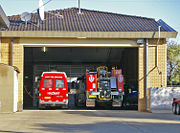 Fire and Rescue NSW conduct a variety of rescue operations state wide, ranging from the release of persons from transport, domestic and industrial incidents to animal rescues. In addition there are specially trained teams that carry out swift water, alpine and vertical rescues and Urban Search and Rescue (USAR). FRNSW Rescue also works in conjunction with other government agencies including the NSW Police Force, Ambulance Service of NSW
Fire and Rescue NSW conduct a variety of rescue operations state wide, ranging from the release of persons from transport, domestic and industrial incidents to animal rescues. In addition there are specially trained teams that carry out swift water, alpine and vertical rescues and Urban Search and Rescue (USAR). FRNSW Rescue also works in conjunction with other government agencies including the NSW Police Force, Ambulance Service of NSW
, the New South Wales Rural Fire Service and the State Emergency Service
. The FRNSW Urban Search and Rescue
Taskforce has been registered by the United Nations for international deployment to assist in disaster situations, particularly earthquakes,throughout the Asia-Pacific region.
Fire and Rescue NSW is responsible for protecting the whole of New South Wales from hazardous materials (hazmat) incidents. The agency has the authority to attend, combat and render safe any land-based or inland waterway spillage of hazardous materials within the State. All fire stations are equipped with trained personnel and resources for dealing with hazmat incidents. Each fire station receives hazardous materials awareness training and equipment to combat minor spills of hydrocarbons, gas leaks and emergency decontamination procedures. Fire and Rescue NSW has six specialist heavy Hazardous Materials Response Units operating from Sydney (Greenacre, Alexandria & St Marys), Newcastle, Berkley Vale and Shellharbour. They have advanced capabilities in detection of toxic industrial chemicals, volatile substances and chemical warfare agents. Intermediate hazardous materials response is delivered by 14 strategically located units, including six with a waterways response capability. Each unit is equipped with detection equipment and has the capability to access chemical databases with information on chemical, biological, radiological and toxic industrial chemical substances.
Fire and Rescue NSW supports the Rural Fire Service of NSW during and after bushfires in New South Wales.
The FRNSW Counter-terrorism and Aviation Unit was established in March 2003 to manage the planning, development and implementation of the counter-terrorism and aviation capability.
Fire and Rescue NSW jointly funds and operates a BK 117 helicopter
in partnership with the NSW Police Aviation Support Branch. The helicopter's primary role is response during the crisis and consequence management phases of a terrorist event. It also provides general air transport of both equipment and personnel for complex and/or protracted hazardous materials or rescue incidents and firefighting operations.
FRNSW’ Fire Investigation and Research Unit (FIRU) provides a range of investigative and research services to both internal and external customers including research into human and structural behaviour during fire, and the associated impacts for performance based building design. The Fire Investigation and Research Unit assists with determining fire causes and liaises closely with Police and other investigators.
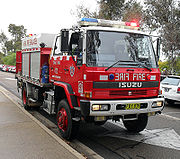
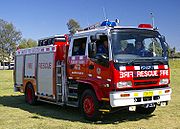 All FRNSW appliances (fire engines) are custom designed. The specialised equipment to be carried on appliances is drawn from a standardised listing which forms a managed inventory and is specific to each appliance type and model. Standardisation of inventory is extremely important as this ensures equipment is stowed in an approved and ergonomic manner. It is also ensures the appliance is not overloaded and is within its legal load carrying capacity.
All FRNSW appliances (fire engines) are custom designed. The specialised equipment to be carried on appliances is drawn from a standardised listing which forms a managed inventory and is specific to each appliance type and model. Standardisation of inventory is extremely important as this ensures equipment is stowed in an approved and ergonomic manner. It is also ensures the appliance is not overloaded and is within its legal load carrying capacity.
In 2008 the then NSWFB changed the way it designated its pumping appliances. Prior to the change, there were:
Any type of appliance could be further specialised with rescue or hazmat equipment.
Due to the differences between several types being only minor, and the 4x2 Type 1 being withdrawn and rebuilt as rescue appliances, the system was simplified into 3 basic classes:
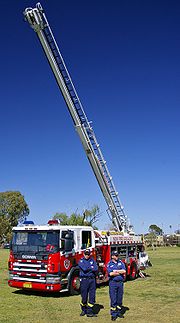
(PPE) and generally consists of tunic, flash hoods, boots, helmet, gloves, breathing apparatus, overtrousers and other assorted items such as bushfire jackets, high-visibility safety vests, cold and extreme climate clothing, and wet weather clothing.
Government agency
A government or state agency is a permanent or semi-permanent organization in the machinery of government that is responsible for the oversight and administration of specific functions, such as an intelligence agency. There is a notable variety of agency types...
of the Government of New South Wales
Government of New South Wales
The form of the Government of New South Wales is prescribed in its Constitution, which dates from 1856, although it has been amended many times since then...
, Australia
Australia
Australia , officially the Commonwealth of Australia, is a country in the Southern Hemisphere comprising the mainland of the Australian continent, the island of Tasmania, and numerous smaller islands in the Indian and Pacific Oceans. It is the world's sixth-largest country by total area...
, is responsible for firefighting, rescue
Rescue
Rescue refers to responsive operations that usually involve the saving of life, or prevention of injury during an incident or dangerous situation....
and hazmat services in the major cities, metropolitan areas and towns across rural and regional New South Wales
New South Wales
New South Wales is a state of :Australia, located in the east of the country. It is bordered by Queensland, Victoria and South Australia to the north, south and west respectively. To the east, the state is bordered by the Tasman Sea, which forms part of the Pacific Ocean. New South Wales...
. Fire and Rescue NSW is the seventh largest urban fire service in the world, with more than 6,900 firefighters serving at 339 fire stations throughout the state, 418 support staff, and 6,000 community fire unit volunteers. It also works closely with the Rural Fire Service
New South Wales Rural Fire Service
The New South Wales Rural Fire Service is a volunteer-based firefighting agency and statutory body of the NSW Government. The NSW RFS is responsible for the general administration of rural fire management affairs including administration of the Rural Fire Fighting Fund, co-ordination with local...
.
The agency operates pursuant to powers set out in the and was initially formed in 1910 as the New South Wales Fire Brigades, with its origins going back to 1884 as the Metropolitan Fire Brigade.
The agency is led by the Commissioner of Fire and Rescue NSW, currently Greg Mullins AFSM
Australian Fire Service Medal
The Australian Fire Service Medal is awarded for distinguished service by a member of an Australian fire service.The AFSM was introduced in 1988, and replaced the Imperial awards of the Queen's Fire Service Medal for Gallantry and the Queen's Fire Service Medal for Distinguished Service...
, who reports to the Ministry for Police and Emergency Services
New South Wales Ministry for Police
The New South Wales Ministry for Police is a ministry of the Government of New South Wales. It has responsibility for three government agencies:*New South Wales Crime Commission*New South Wales Police*New South Wales Police Integrity Commission...
, which is ultimately responsible to the Minister for Police and Emergency Services
Minister for Police and Emergency Services (New South Wales)
The New South Wales Minister for Police and Emergency Services has responsibilities which includes bus and ferry policy, contracting and regulation, rail policy, fares and concessions, and taxi and hire car policy and regulation...
, currently the Honourable Michael Gallacher, MLC.
History
The New South Wales Fire Brigades (NSWFB) was established in September 1909, replacing the Sydney based Metropolitan Fire Brigade, which formed in February 1884. Prior to its formation, Fire Brigade Boards also ran rudimentary fire services in various New South Wales country towns. On 1 January 2011 the agency was re-named to Fire and Rescue NSW to better reflect the agency's expanding responsibilities.Emblem
The Fire and Rescue NSW emblem includes the NSW state emblem with the State motto Orta Recens Quam Pura Nites, which is Latin for 'Newly Risen How Brightly We Shine'.A flag
Flag
A flag is a piece of fabric with a distinctive design that is usually rectangular and used as a symbol, as a signaling device, or decoration. The term flag is also used to refer to the graphic design employed by a flag, or to its depiction in another medium.The first flags were used to assist...
based on the British
United Kingdom
The United Kingdom of Great Britain and Northern IrelandIn the United Kingdom and Dependencies, other languages have been officially recognised as legitimate autochthonous languages under the European Charter for Regional or Minority Languages...
Blue Ensign
Blue Ensign
The Blue Ensign is a flag, one of several British ensigns, used by certain organisations or territories associated with the United Kingdom. It is used either plain, or defaced with a badge or other emblem....
with FRNSW emblem is also used.
Commissioner
Greg Mullins was appointed Commissioner of the NSW Fire Brigades (now Fire & Rescue NSW) on 4 July 2003. He is the first person in the history of the brigade to be appointed as both Chief Fire Officer / CEO, and to have come from the Brigades’ ranks. Commissioner Mullins joined the then NSWFB in 1978 after serving for six years as a volunteer firefighter with the NSW Rural Fire Service. He rose steadily through the ranks serving in operational and specialist positions, becoming a Station Officer in 1990, a District Officer (Inspector) in 1992, a Superintendent in 1995, and an Assistant Commissioner in 1996. In 2000 he was appointed as Director State Operations. A former Churchill Fellow, he has represented Australian fire services nationally and internationally on issues concerning emergency management, managing the consequences of terrorist attacks, and urban search and rescue.The Commissioner's official vehicle bears New South Wales number plate
Number plate
A number plate may be:* a vehicle registration plate* a plate attached to a locomotive indicating their number, particularly in the UK and Australia, which are often collected as memorabilia....
10, which has been on continuous issue to the head of the fire department in NSW from the Roads and Maritime Services
Roads and Maritime Services
Roads and Maritime Services is an agency of the New South Wales Government responsible for building and maintaining road infrastructure and managing the day-to-day compliance and safety for roads and waterways....
since 1910.
Organisation
- Permanent Stations
A permanent firefighter is a full-time firefighter. Permanent firefighters work in a fire station as part of a platoon. Each fire station has four platoons on rotating shifts each containing at least 3 firefighters of various ranks, plus a Station Officer. The number depends on the size and nature of the fire station. Each platoon is supervised by a Station Officer. Each fire station is part of a zone containing between nine and 27 fire stations and headed by a zone commander. These zones are then grouped in regions (metropolitan, regional north, regional south, and regional west) headed by a Regional Commander.
- Retained Stations
A retained station is a part-time station where retained firefighters work. Even though these firefighters work part-time, it should be noted that these members of the community (who often have other full-time employment) are considered professional firefighters who have undergone training so they can attend the same jobs as permanent firefighters. The retained station is not a permanently staffed station, meaning the firefighters are on-call from home or work rather than on duty at the station. However, retained stations respond to emergencies 24 hours a day. Retained firefighters use the same vehicles, equipment and uniforms as their permanent counterparts, the only visible differences being their shoulder and helmet ranks which are red as opposed to white/black.
- Mixed Stations
Some stations employ a mixture of Permanent and Retained Firefighters. This arrangement is common in larger country towns such as Bathurst and Orange where the nearest backup would otherwise be some distance away. The station would typically have one appliance manned by permanent staff as first response, with additional vehicles being manned by retained staff as required. The station may have Permanent day and night shifts or be day shift only, with retained staff manning all appliances at night when they are less hampered by work or other commitments.
- Community fire unit volunteers
Community fire unit
Community fire unit
Community Fire Units are volunteer teams of residents who are trained as preliminary responders to bushfires until the fire brigade arrives and in bushfire prevention...
s (CFUs) are volunteer teams of local residents trained to safeguard their homes during a bushfire, until the fire brigades can get there, or to 'mop up' after a fire has passed so fire units can be released to attend more urgent incidents. CFU members are not firefighters. The aim of the CFU program is to reduce the impact of bushfires on the community and to protect life and property from bushfires. A typical team is made up of six to 12 members. Recruitment is within the local community. Local fire stations conduct regular training sessions with volunteers. The training focus is on bushfire education, prevention and preparation.
Area of service in New South Wales
Fire and Rescue NSW has 339 stations across NSW protecting 90% of the State's population from fire, and 100% of the population from hazardous materials incidents- Rescue

Ambulance Service of New South Wales
The Ambulance Service of New South Wales , an agency of the Department of Health of the New South Wales Government, is the main provider of pre-hospital emergency care and ambulance services in the state of New South Wales, Australia....
, the New South Wales Rural Fire Service and the State Emergency Service
New South Wales State Emergency Service
The New South Wales State Emergency Service is an emergency and rescue service dedicated to assisting the community. It is made up almost entirely of volunteers, with 228 units located throughout New South Wales. The units are composed of some 10,000 volunteer members, who are easily identified by...
. The FRNSW Urban Search and Rescue
Urban search and rescue
Urban search and rescue involves the location, extrication, and initial medical stabilization of victims trapped in confined spaces due to natural disasters, structural collapse, transportation accidents, mines and collapsed trenches.USAR teams in different countries may be organised in a...
Taskforce has been registered by the United Nations for international deployment to assist in disaster situations, particularly earthquakes,throughout the Asia-Pacific region.
- Hazardous materials (HAZMAT)
Fire and Rescue NSW is responsible for protecting the whole of New South Wales from hazardous materials (hazmat) incidents. The agency has the authority to attend, combat and render safe any land-based or inland waterway spillage of hazardous materials within the State. All fire stations are equipped with trained personnel and resources for dealing with hazmat incidents. Each fire station receives hazardous materials awareness training and equipment to combat minor spills of hydrocarbons, gas leaks and emergency decontamination procedures. Fire and Rescue NSW has six specialist heavy Hazardous Materials Response Units operating from Sydney (Greenacre, Alexandria & St Marys), Newcastle, Berkley Vale and Shellharbour. They have advanced capabilities in detection of toxic industrial chemicals, volatile substances and chemical warfare agents. Intermediate hazardous materials response is delivered by 14 strategically located units, including six with a waterways response capability. Each unit is equipped with detection equipment and has the capability to access chemical databases with information on chemical, biological, radiological and toxic industrial chemical substances.
- Bushfire/Natural Hazards
Fire and Rescue NSW supports the Rural Fire Service of NSW during and after bushfires in New South Wales.
- Counter-terrorismCounter-terrorismCounter-terrorism is the practices, tactics, techniques, and strategies that governments, militaries, police departments and corporations adopt to prevent or in response to terrorist threats and/or acts, both real and imputed.The tactic of terrorism is available to insurgents and governments...
The FRNSW Counter-terrorism and Aviation Unit was established in March 2003 to manage the planning, development and implementation of the counter-terrorism and aviation capability.
Fire and Rescue NSW jointly funds and operates a BK 117 helicopter
Helicopter
A helicopter is a type of rotorcraft in which lift and thrust are supplied by one or more engine-driven rotors. This allows the helicopter to take off and land vertically, to hover, and to fly forwards, backwards, and laterally...
in partnership with the NSW Police Aviation Support Branch. The helicopter's primary role is response during the crisis and consequence management phases of a terrorist event. It also provides general air transport of both equipment and personnel for complex and/or protracted hazardous materials or rescue incidents and firefighting operations.
- Fire investigation and research
FRNSW’ Fire Investigation and Research Unit (FIRU) provides a range of investigative and research services to both internal and external customers including research into human and structural behaviour during fire, and the associated impacts for performance based building design. The Fire Investigation and Research Unit assists with determining fire causes and liaises closely with Police and other investigators.
Fire Engines (Appliances)


Water Tankers
FRNSW has a total of 110 4x4 water tanker appliances:| Class | Chassis make and model | Body manufacturer | Commissioned | Number | Crew capacity |
|---|---|---|---|---|---|
| Tanker Class 1 (4x4) | Isuzu FTS750 | Mills Tui Australia Pty. Ltd., Queensland | 20032004 | 8 vehicles | 6 |
Pumpers
FRNSW has a total of 408 pumping appliances:| Class (Previous class) |
Chassis make and model | Body manufacturer | Commissioned | Number | Crew capacity |
|---|---|---|---|---|---|
| Pumper Class 2 (Pumper Type 2) |
Isuzu FTR800 | Skilled Equipment Manufacturing Limited | 19992003 | 139 vehicles | 6 |
| Pumper Class 3 (Varley Commander) (Pumper Type 3) |
VSV Commander Mk3 | Varley Specialised Vehicles Limited | 20012005 | 52 vehicles | 6 |
| Pumper Class 3 (Scania) | Scania | Varley Specialised Vehicles Limited (1 unit) SEM Fire and Rescue (Up to 84 units) |
2008present | 85 vehicles currently in production |
5 |
| Pumper Class 3 (Scania P94D) (Pumper Type 4) |
Scania P94 DB4x2NA 310 Crew Cab |
Australian Fire Company | 20002001 | 12 vehicles | 5 |
| Pumper Class 3 (Varley Commander) (Pumper Type 4) |
VSV Commander Mk2 | Varley Specialised Vehicles Limited | 20002004 | 37 vehicles | 6 |
| Pumper Class 3 (Varley Commander SP) (Pumper Type 5) |
VSV Commander Mk2 | Varley Specialised Vehicles Limited | 2000 | 12 vehicles | unknown |
In 2008 the then NSWFB changed the way it designated its pumping appliances. Prior to the change, there were:
- Tankers (4x4 Ind pumper). Isuzu 4x4 FRS, FTS & FTS750.
- Type 1 (4x2 Ind pumper). Isuzu FTR800.
- Type 2 (4x2 Pto medium pumper), Isuzu FTR800 & FTR900.
- Type 3 (4x2 Pto Medium / Urban pumper), Inter 1810 & 2250, Austral Firepac, Scania 93M, Varley Commander II, Mercedes 1625, Volvo F17
- Type 4 (4x2 Pto Urban pumper) Scania 94D, Varley Commander I
- Type 5 (4x2 Pto Super Pumper). Varley Commander I SP.
Any type of appliance could be further specialised with rescue or hazmat equipment.
Due to the differences between several types being only minor, and the 4x2 Type 1 being withdrawn and rebuilt as rescue appliances, the system was simplified into 3 basic classes:
- Class 1 - 4x4 Tankers (standard, Rescue & Hazmat variants), Isuzu 4x4 FRS, FTS & FTS750.
- Class 2 - 4x2 Medium Pumper (standard & Rescue), Isuzu FTR800, Inter 1810
- Class 3 - 4x2 Urban Pumper (The old types 3, 4 & 5, in standard, rescue and Hazmat variants). Inter 2250, Austral Firepac, Scania 93M, 94D & P310, Varley Commander I & II, Mercedes 1625, Volvo F17
Aerials
FRNSW has a total of 25 aerial appliances:
| Class | Chassis make and model | Body manufacturer | Commissioned | Number | Crew capacity |
|---|---|---|---|---|---|
| Aerial Pumper | Scania P94 | Alexander Perrie & Co. Pty. Ltd. | 2009present | Up to 3 vehicles currently in production |
5 |
| Aerial Pumper | Scania P94 GB6x4NB 310 | Mills-Tui Ltd., New Zealand | 20002001 | 10 vehicles | 5 |
| Turntable Ladder | Iveco EuroMover 190 E 34 | Iveco Magirus AG / Varley Spec. Vehicles | 20012003 | 2 vehicles | 2 |
| Aerial Ladder Platform 37m (Mercedes/Bronto) | Mercedes Benz K2435 | Alexander Perrie & Co. Pty. Ltd. | 19962001 | 6 vehicles | 2 |
| Aerial Ladder Platform 37m (Scania/Bronto) | Scania P124 GB 8x4 | Alexander Perrie & Co. Pty. Ltd. | 2004 | 1 vehicle | 2 |
| Aerial Ladder Platform 27m (Scania/Bronto) | Scania P94 GB 4x2 | Alexander Perrie & Co. Pty. Ltd. | 2004 | 1 vehicle | unknown |
Hazardous Materials (HAZMAT)
FRNSW has a total of 32 HazMat appliances| Class | Chassis make and model | Body/trailer manufacturer | Commissioned | Decommissioned | Number | Crew capacity |
|---|---|---|---|---|---|---|
| BA Training Trailer | Mercedes Benz Actros 2648 (6x4) | Maxicube Trailers Pty. Ltd. | 1999 | n/a | 1 vehicle | 2 |
| Heavy HazMat (Austral Firepac) | Austral Firepac 3500 | Austral Specialised Vehicles | 1997 | 2009 | 1 vehicle | 2 |
| Heavy HazMat (International) | International 1850G LPV | Mills-Tui Limited, New Zealand | 19992000 | 2009 Moved to Service-Exchange status |
3 vehicles | 3 |
| Heavy HazMat (Isuzu) | Isuzu 950 Long | Varley Specialised Vehicles | 20072008 | n/a | 6 vehicles | 2 |
| C02 | Isuzu FRR550 Crew Cab | Mills-Tui Limited (Australia) | 2001 | n/a | 1 vehicle | 3 |
| HazMat Van | Mercedes Benz Sprinter 413CDI high roof | Caddy Storage Systems | 20002002 | n/a | 22 vehicles | 2 |
Rescue
FRNSW has a total of 38 rescue appliances:| Class | Chassis make and model | Body manufacturer | Commissioned | Number | Crew capacity |
|---|---|---|---|---|---|
| Heavy Rescue (Isuzu) | Isuzu FVR1000 | Mills Tui Australia Pty. Ltd., Queensland | 2009present | 3 vehicles currently in production |
2 |
| Heavy Rescue (Isuzu) | Isuzu FVR950 Heavy Duty | Austral Specialised Vehicles | 20002001 | 10 vehicles | 2 |
| Heavy Rescue (Austral) | Austral Firepac 3500 | Mills Tui Australia Pty. Ltd., Queensland | 1997 | 3 vehicles | 2 |
| City of Sydney Varley Rescue | VSV Commander Mk2 | Varley Specialised Vehicles Limited | 2001 | 1 vehicle | 6 |
| Rescue Van | Mercedes Benz Sprinter 413CDI high roof | Caddy Storage Systems | 20002002 | 42 vehicles | 2 |
| Modular (Pod) Transport System | International 2350G | Commercial Engineering and Technology /Cooks Body Works Pty. Ltd. | 1999 | 2 vehicles | 3 |
| USAR 1 | Mercedes Benz Actros 2653 (6x4) | Peki Transport Equipment Pty. Limited | 2004 | 1 vehicle | 2 |
| FireAir 1 | Kawasaki BK 117 helicopter Jointly owned by Fire and Rescue NSW and NSW Police and used for the rapid deployment of specialist resources for tactical operations, forensic services, bomb disposal, chemical, biological, and radiological detection/decontamination, and urban search and rescue |
7 December ____ | 1 vehicle | unknown | |
| Incident Control Vehicle | MAN 11.160 HOCL | PMC (Adelaide), Fitted out by Fire and Rescue NSW | 19971998 | 2 vehicles | 3 |
Uniform
As well as the obvious danger of heat, firefighters are exposed to toxic fumes, sharp objects, uneven ground, slippery surfaces, biological fluids, spilt chemicals and electricity. Due to these hazards, firefighting uniforms need to provide the best possible protection. Firefighting ensembles are known as Personal Protective EquipmentPersonal protective equipment
Personal protective equipment refers to protective clothing, helmets, goggles, or other garment or equipment designed to protect the wearer's body from injury by blunt impacts, electrical hazards, heat, chemicals, and infection, for job-related occupational safety and health purposes, and in...
(PPE) and generally consists of tunic, flash hoods, boots, helmet, gloves, breathing apparatus, overtrousers and other assorted items such as bushfire jackets, high-visibility safety vests, cold and extreme climate clothing, and wet weather clothing.
See also
- Firefighting
- New South Wales Rural Fire ServiceNew South Wales Rural Fire ServiceThe New South Wales Rural Fire Service is a volunteer-based firefighting agency and statutory body of the NSW Government. The NSW RFS is responsible for the general administration of rural fire management affairs including administration of the Rural Fire Fighting Fund, co-ordination with local...
- Country Fire ServiceCountry Fire ServiceThe SA Country Fire Service is a volunteer based fire service in the state of South Australia in Australia. Many parts of Australia are sparsely populated whilst at the same time they are under significant risk of bushfire. Due to economics, it is prohibitively expensive for each Australian town...
- Country Fire AuthorityCountry Fire AuthorityCountry Fire Authority, or CFA, is the name of the fire service that provides firefighting and other emergency services to all of the country areas and regional townships within the state of Victoria, Australia, as well as large portions of the outer suburban areas and growth corridors of Melbourne...
External links
- Fire & Rescue NSW official website
- NSW Rural Fire Service Website
- Museum of Fire
- NSW Fire Brigade Employees Union
- NSW Fire Brigade Training Facility 33°54′19"S 151°12′3"E

